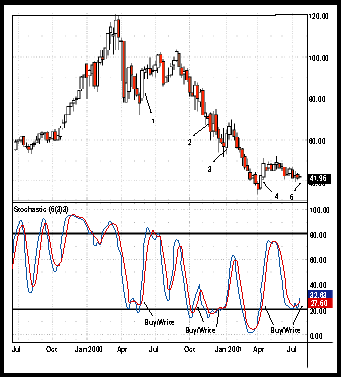OPTIONS
When To Buy, When To Exit, And How To Protect Equity Plays
Overbought/Oversold, With Covered Calls
by Austin Passamonte
Knowing when to buy and when to exit or how to protect equity plays is basic for long-term prosperity. Here is one way to do it using covered calls.
Every stock trader should be ready and willing to write covered calls. They are a powerful tool for locking in partial gains and/or reducing cost basis. By the same token, writing covered calls as a specific trading method also holds great merit. Let's explore some scenarios for such tactics and see if they might add to your personal equity curve.
MECHANICS OF TRADING COVERED CALLS
Option contracts are actively traded for literally thousands of listed stocks, sectors, indexes, and exchange-traded funds such as iShares and Holdrs. Simple tactics for hedging, investing, and/or locking in profits have never been more available or diverse.
Here's a simple rule: Never write a covered call on a share you don't want to own. Covered call writing is a neutral to bullish strategy, but markets can always quickly turn bearish. If that happens, you should not be stuck holding anything you are not content to keep.
For this reason, I prefer writing covered calls on Holdrs and iShares,
indexes that track an underlying sector or index. A diverse assortment
of liquid shares that also trade options is listed on the American Stock
Exchange (AMEX). All Holdrs and Standard & Poor's 100 (OEF) iShares,
among others, have option contracts available. These vehicles are made
up of a blend of related companies with more safety from adverse market
behavior than individual companies can expect. Likewise, several solid
investment candidates are found in the Dow Jones Industrial Average (DJIA),
Nasdaq 100, and Standard & Poor's 100 and 500, as well as other major
indexes.

FIGURE 1: Weekly chart of the QQQ. You can make profitable trades by using the stochastic oscillator.
VOLATILITY
The consensus is that we sell option contracts when volatility premium value is high and buy them when volatility is low. Correlations for these values are found at Chicago Board Options Exchange's (CBOE) volatility index (VIX). A high VIX reading suggests fear in the broad market and a possible bottom at hand. This is an ideal condition for selling covered calls as a profit strategy or cash-generating method. Low VIX readings occur during periods of market complacency near market tops before a subsequent decline. At this point, you can use covered calls as defensive or cost-reduction vehicles by selling them short.
You will be tempted to research which option contracts currently sell for the highest implied volatility regardless of the underlying, so you can write covered calls to get those gaudy returns. Individual stocks that are perceived to have wide price swings will have extreme implied volatility. This could be good or bad, depending on which way the price moves. When you write a covered call, it must always be based on an underlying company, sector, or index that offers the minimum downside security your capital account and level of risk requires.
...Continued in the November 2001 issue of Technical Analysis of STOCKS & COMMODITIES.
Austin Passamonte is the editor of IndexSkybox.com, a trading website
that provides education on equity indexes, sectors, and options.
Excerpted from an article originally published in the November 2001 issue of Technical Analysis of STOCKS & COMMODITIES magazine. All rights reserved. © Copyright 2001, Technical Analysis, Inc.